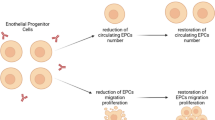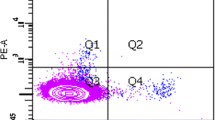Abstract
Scleroderma (systemic sclerosis) is a disease of unknown origins that involves tissue ischemia and fibrosis in the skin and internal organs such as the lungs. The tissue ischemia is due to a lack of functional blood vessels and an inability to form new blood vessels. Bone marrow-derived circulating endothelial progenitor cells play a key role in blood vessel repair and neovascularization. Scleroderma patients appear to have defects in the number and function of circulating endothelial progenitor cells. Scleroderma patients also develop fibrotic lesions, possibly as the result of tissue ischemia. Fibroblast-like cells called fibrocytes that differentiate from a different pool of bone marrow-derived circulating progenitor cells seem to be involved in this process. Manipulating the production, function, and differentiation of circulating progenitor cells represents an exciting new possibility for treating scleroderma.
Similar content being viewed by others
References and Recommended Reading
Abraham DJ, Varga J: Scleroderma: from cell and molecular mechanisms to disease models. Trends Immunol 2005, 26:587–595.
Zhou X, Tan FK, Wang N, et al.: Genome-wide association study for regions of systemic sclerosis susceptibility in a Choctaw Indian population with high disease prevalence. Arthritis Rheum 2003, 48:2585.
Bucala R, Spiegel L, Chesney J, et al.: Circulating fibrocytes define a new leukocyte subpopulation that mediates tissue repair. Mol Med 1994, 1:71–81.
Zhao Y, Glesne D, Huberman E: A human peripheral blood monocyte-derived subset acts as pluripotent stem cells. Proc Natl Acad Sci U S A 2003, 100:2426–2431.
Hinchcliff M, Varga J: Novel paradigm for treating vasculopathy in systemic sclerosis: vascular progenitor cells and statins. Curr Rheumatol Rep 2007, 9:1–3.
Hristov M, Weber C: Endothelial progenitor cells: characterization, pathophysiology, and possible clinical relevance. J Cell Mol Med 2004, 8:498–508.
Takahashi T, Kalka C, Masuda H, et al.: Ischemia-and cytokine-induced mobilization of bone marrow-derived endothelial progenitor cells for neovascularization. Nat Med 1999, 5:434–438.
Smadja DM, Cornet A, Emmerich J, et al.: Endothelial progenitor cells: characterization, in vitro expansion, and prospects for autologous cell therapy. Cell Biol Toxicol 2007, 23:223–239.
Asahara T, Murohara T, Sullivan A, et al.: Isolation of putative progenitor endothelial cells for angiogenesis. Science 1997, 275:964–967.
Crosby JR, Kaminski WE, Schatteman G, et al.: Endothelial cells of hematopoietic origin make a significant contribution to adult blood vessel formation. Circ Res 2000, 87:728–730.
Murasawa S, Asahara T: Endothelial progenitor cells for vasculogenesis. Physiology (Bethesda) 2005, 20:36–42.
Kuwana M, Okazaki Y, Yasuoka H, et al.: Defective vasculogenesis in systemic sclerosis. Lancet 2004, 364:603–610.
Del Papa N, Quirici N, Soligo D, et al.: Bone marrow endothelial progenitors are defective in systemic sclerosis. Arthritis Rheum 2006, 54:2605–2615.
Allanore Y, Batteux F, Avouac J, et al.: Levels of circulating endothelial progenitor cells in systemic sclerosis. Clin Exp Rheumatol 2007, 25:60–66.
Distler O, Del Rosso A, Giacomelli R, et al.: Angiogenic and angiostatic factors in systemic sclerosis: increased levels of vascular endothelial growth factor are a feature of the earliest disease stages and are associated with the absence of fingertip ulcers. Arthritis Res 2002, 4:R11.
Mulligan-Kehoe MJ, Drinane MC, Mollmark J, et al.: Antiangiogenic plasma activity in patients with systemic sclerosis. Arthritis Rheum 2007, 56:3448–3458.
Ito H, Rovira, II, Bloom ML, et al.: Endothelial progenitor cells as putative targets for angiostatin. Cancer Res 1999, 59:5875–5877.
Cipriani P, Guiducci S, Miniati I, et al.: Impairment of endothelial cell differentiation from bone marrow-derived mesenchymal stem cells: new insight into the pathogenesis of systemic sclerosis. Arthritis Rheum 2007, 56:1994–2004.
Deshane J, Chen S, Caballero S, et al.: Stromal cell-derived factor 1 promotes angiogenesis via a heme oxygenase 1-dependent mechanism. J Exp Med 2007, 204:605–618.
Tourkina E, Gooz P, Oates JC, et al.: Curcumin-induced apoptosis in scleroderma lung fibroblasts: role of protein kinase cepsilon. Am J Respir Cell Mol Biol 2004, 31:28–35.
Schmidt M, Sun G, Stacey M, et al.: Identification of circulating fibrocytes as precursors of bronchial myofibroblasts in asthma. J Immunol 2003, 171:380–389.
Wang J, Jiao H, Stewart TL, et al.: Improvement in postburn hypertrophic scar after treatment with IFN-alpha2b is associated with decreased fibrocytes. J Interferon Cytokine Res 2007, 27:921–930.
Bellini A, Mattoli S: The role of the fibrocyte, a bone marrow-derived mesenchymal progenitor, in reactive and reparative fibroses. Lab Invest 2007, 87:858–870.
Hur J, Yoon CH, Kim HS, et al.: Characterization of two types of endothelial progenitor cells and their different contributions to neovasculogenesis. Arterioscler Thromb Vasc Biol 2004, 24:288–293.
Haudek SB, Xia Y, Huebener P, et al.: Bone marrow-derived fibroblast precursors mediate ischemic cardiomyopathy in mice. Proc Natl Acad Sci U S A 2006, 103:18284–18289.
Kraling BM, Maul GG, Jimenez SA: Mononuclear cellular infiltrates in clinically involved skin from patients with systemic sclerosis of recent onset predominantly consist of monocytes/macrophages. Pathobiology 1995, 63:48.
Abraham D, Distler O: How does endothelial cell injury start? The role of endothelin in systemic sclerosis. Arthritis Res Ther 2007, 9(Suppl 2):S2.
Chesney J, Metz C, Stavitsky AB, et al.: Regulated production of type I collagen and infl ammatory cytokines by peripheral blood fibrocytes. J Immunol 1998, 160:419–425.
Hartlapp I, Abe R, Saeed RW, et al.: Fibrocytes induce an angiogenic phenotype in cultured endothelial cells and promote angiogenesis in vivo. FASEB J 2001, 15:2215.
Wang JF, Jiao H, Stewart TL, et al.: Fibrocytes from burn patients regulate the activities of fibroblasts. Wound Repair Regen 2007, 15:113–21.
Postlethwaite AE, Shigemitsu H, Kanangat S: Cellular origins of fibroblasts: possible implications for organ fibrosis in systemic sclerosis. Curr Opin Rheumatol 2004, 16:733–738.
Russo R, Medbury H, Guiffre A, et al.: Lack of increased expression of cell surface markers for circulating fibrocyte progenitors in limited scleroderma. Clin Rheumatol 2007, 26:1136–1141.
Mehrad B, Burdick MD, Zisman DA, et al.: Circulating peripheral blood fibrocytes in human fibrotic interstitial lung disease. Biochem Biophys Res Commun 2007, 353:104–108.
Aiba S, Tabata N, Ohtani H, et al.: CD34+ spindle-shaped cells selectively disappear from the skin lesion of scleroderma. Arch Dermatol 1994, 130:593–597.
Cowper SE: Nephrogenic systemic fibrosis: a review and exploration of the role of gadolinium. Adv Dermatol 2007, 23:131–154.
Vasa M, Fichtlscherer S, Adler K, et al.: Increase in circulating endothelial progenitor cells by statin therapy in patients with stable coronary artery disease. Circulation 2001, 103:2885–2890.
Llevadot J, Murasawa S, Kureishi Y, et al.: HMG-CoA reductase inhibitor mobilizes bone marrow-derived endothelial progenitor cells. J Clin Invest 2001, 108:399–405.
Kuwana M, Kaburaki J, Okazaki Y, et al.: Increase in circulating endothelial precursors by atorvastatin in patients with systemic sclerosis. Arthritis Rheum 2006, 54:1946–1951.
Hristov M, Fach C, Becker C, et al.: Reduced numbers of circulating endothelial progenitor cells in patients with coronary artery disease associated with long-term statin treatment. Atherosclerosis 2007, 192:413–420.
Dazzi F, van Laar JM, Cope A, et al.: Cell therapy for autoimmune diseases. Arthritis Res Ther 2007, 9:206.
van Laar JM, Tyndall A: Adult stem cells in the treatment of autoimmune diseases. Rheumatology (Oxford) 2006, 45:1187–1193.
Tyndall A, Furst DE: Adult stem cell treatment of scleroderma. Curr Opin Rheumatol 2007, 19:604–610.
Ravagnani F, Siena S, Bregni M, et al.: Methodologies to estimate circulating hematopoietic progenitors for autologous transplantation in cancer patients. Haematologica 1991, 76(Suppl 1):46–49.
Murasawa S, Asahara T: Gene modified cell transplantation for vascular regeneration. Curr Gene Ther 2007, 7:1–6.
Gordon MY, Goldman JM, Gordon-Smith EC: 4-Hydroperoxycyclophosphamide inhibits proliferation by human granulocyte-macrophage colony-forming cells (GM-CFC) but spares more primitive progenitor cells. Leuk Res 1985, 9:1017–1021.
Brodsky RA, Sensenbrenner LL, Smith BD, et al.: Durable treatment-free remission after high-dose cyclophosphamide therapy for previously untreated severe aplastic anemia. Ann Intern Med 2001, 135:477–483.
Tehlirian CV, Hummers LK, White B, et al.: High dose cyclophosphamide without stem cell rescue in scleroderma. Ann Rheum Dis 2007 (Epub ahead of print)
Pilling D, Buckley CD, Salmon M, et al.: Inhibition of fibrocyte differentiation by serum amyloid P. J Immunol 2003, 17:5537–5546.
Tennent GA, Dziadzio M, Triantafillidou E, et al.: Normal circulating serum amyloid P component concentration in systemic sclerosis. Arthritis Rheum 2007, 56:2013–2017.
Pilling D, Roife D, Wang M, et al.: Reduction of bleomycininduced pulmonary fibrosis by serum amyloid P. J Immunol 2007, 179:4035–4044.
Author information
Authors and Affiliations
Corresponding author
Rights and permissions
About this article
Cite this article
Gomer, R.H. Circulating progenitor cells and scleroderma. Curr Rheumatol Rep 10, 183–188 (2008). https://doi.org/10.1007/s11926-008-0031-8
Published:
Issue Date:
DOI: https://doi.org/10.1007/s11926-008-0031-8




